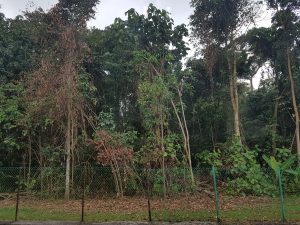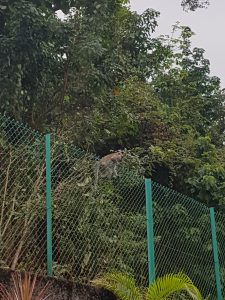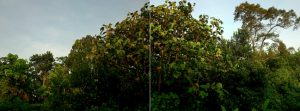Singapore, the Garden City of Asia, boasts its lush greenery and abundant biodiversity. But all is not always as such. The recent toppling of a tembusu tree at the Singapore Botanic Gardens sparked major concern in Singapore when it killed a person and injured four others. This is not the first incident of tree fall that has cost a life or property damage. In fact, these incidents began as early as 2013.
Four years ago, a forest tree fell right into my house. That’s right, urban ecology in my backyard. I remember walking into the kitchen to get my fix of caffeine when a slow, loud and unusual creaking sound resonated from the backyard. I headed out to investigate. A huge tree and its massive foliage came tumbling down with a loud whoosh. Roofs were broken, fences were bent and branches were everywhere. Fortunately, no one was injured. (Personally, it was an amazing experience to see a tree fall (without getting injured), but it was a nightmare for my parents.)
This year, the trees came back and vegetation crept closer to my house. The fall of the tembusu sent my neighbourhood into another email frenzy with the National Parks Board (NParks). They wanted their backyards to be safe spaces. This meant the trimming of trees and the removal of vegetation from the forest. Their unhappiness and persistence of the matter left me in a dilemma between the interest of my neighbourhood and that of the biota in our backyards. My silent dilemma came to an end when a decision was made. Just last week, workers came with their equipment and started sawing down trees in the forest which were within 5 metres of the neighbourhood. The result? A barren forest edge, the loss of heritage trees, a noticeable decrease in bird calls, macaques walking along the fence, and what the neighbourhood wanted: safer backyards. It is interesting to note that macaques have never been seen along the fence, apart from this week. Did the removal of trees disturb their habitat and cause them to move?

Figure 2. The forest after the removal of trees and vegetation

Figure 3. Macaque spotted on the fence
This issue taught me that the complaints never stop. People perpetually seem to have problems with living with nature. Rarely do they take into account the geographical context of their location. Singapore is located in the vibrant tropics, with a beautiful diversity of plants and animals. We have the North-East monsoon which sends thunderstorms and turbulent winds to our island twice a year. It sways the trees in an exotic dance against the backdrop of falling leaves. This is nature. Perhaps, we should learn to treasure the invaluable biota of our land and not take them for granted. Perhaps, we should first learn about nature and how to approach it before we let our fears decide what is best. Perhaps, we should ask ourselves, are they in our way, or are we in their way?
Given the high density and limited space in Singapore, the physical line and distance between humans and wildlife will only be closer and closer. We can choose how to react to it – in anger or appreciation. What will your choice be today?
References
MIN, C. (2017). Tree falls on parked cars at Amoy Street. The Straits Times. Retrieved 17 March 2017, from http://www.straitstimes.com/singapore/tree-fell-on-parked-cars-at-amoy-street
Woman killed by tree fall moved to Singapore in 2013. (2017). The New Paper. Retrieved 17 March 2017, from http://www.tnp.sg/news/singapore/woman-killed-tree-fall-moved-singapore-2013
YANG, C. (2017). Woman killed by tembusu tree at Singapore Botanic Gardens last worked at Mastercard. The Straits Times. Retrieved 17 March 2017, from http://www.straitstimes.com/singapore/woman-killed-by-tembusu-tree-at-singapore-botanic-gardens-last-worked-at-mastercard

I wonder what will happen if the macaque enters your backyard :/
But anyway, I think you raised a great point about the conflict between safety and greenery in Singapore. For NParks, safety is always of higher priority, so they trim branches and remove diseased trees regularly. But I was just thinking, if people spend a lot of money to buy houses near nature because they like to be closer to nature, why complain about it?
I have never witnessed a tree fall and I think that it would be a really cool experience (if I was a safe distance away)! Reading your post, I suddenly recalled that not long after the Tembusu tree fell at Singapore Botanic Gardens, a row of trees right next to the main road near my house were being sawed down. At that time, I was puzzled as to why the authorities would suddenly cut down a row of trees that have been there ever since I first moved to my house eighteen years ago. Now, I think that a plausible reason could be the prevention of more tree falls. If one of the trees had fallen, it would be extremely dangerous due to its close proximity to the road and bus stop. However, I also feel disappointed with the loss of the trees as there is now less greenery and greenery. The treeless grass patch now looks barren and forlorn.
I do agree that the removal of trees could have resulted in the loss of biodiversity via habitat loss. The fauna could have also been ran away when the constructors came by to remove the trees and vegetation. The sawing and trimming of trees actually cause quite a big ruckus and this could have scared away the biodiversity. The macaques could have made use of the vegetation close to the fence to jump onto the fence. With a greater distance between the vegetation edge and the fence now, they may have greater difficulty jumping over, resulting in a drop in sightings on the fence.
Human-wildlife conflicts are extremely prevalent, especially in highly urbanised Singapore where nature reserves are a stone’s throw away from urban areas and lack any buffer areas. It is indeed a mounting challenge to guide Singaporeans to step into the perspective of wildlife and become aware of the need to coexist with native wildlife. It is my hope that greater awareness among Singaporeans on urban ecology would aid in reducing these conflicts. Anyone who have taken LSM4265 would surely react to such conflicts with appreciation instead of complaints!